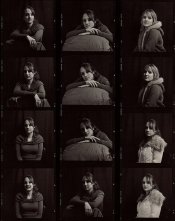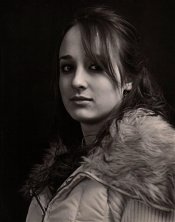I'm playing around with this basic issue and questions surrounding it (perhaps too basic? I don't know) for portrait work. Also been reading a bit about some of the older "looks" which were achieved by under-exposure and over-development. I'm curious what you all think about this approach to images and the effect it has on the finished "look" which is shown
here with these two scans. Film was TX400 at 320, pyrocat, semi-stand with longish development. Lighting was pretty simple, 250 watt umbrella above and right of camera (near), 250 watt umbrella lower and left at about 3 X distance for fill. Black cloth drape on wall behind subject.
The proof sheet is on some cheap Arista MG paper, grade 2 filter setting with dektol. Actual print is made on some PWT (at grade 2) with dektol and selenium. Obviously, the exposure is not correct, as the film edge isn't really black. The print is ok, but I'm wondering what the result would be from a bit more exposure. It would tend to push the high values up on the curve more. I could also use this exposure and add some development time, to stretch the high values and depress the shadows further. Sorry about the scans, my scanner really is an old "so and so" with respect to tonality and color.
Any and all input would be appreciated. I'm playing around with the "older" look and want to see where it takes me. Thanks, tim
P.S. The scans were done on my old system with a CRT display. It doesn't replicate as well on a digital display, but I like the "old" screen for this type work so I've used it for scanning and rendering.
here with these two scans. Film was TX400 at 320, pyrocat, semi-stand with longish development. Lighting was pretty simple, 250 watt umbrella above and right of camera (near), 250 watt umbrella lower and left at about 3 X distance for fill. Black cloth drape on wall behind subject.
The proof sheet is on some cheap Arista MG paper, grade 2 filter setting with dektol. Actual print is made on some PWT (at grade 2) with dektol and selenium. Obviously, the exposure is not correct, as the film edge isn't really black. The print is ok, but I'm wondering what the result would be from a bit more exposure. It would tend to push the high values up on the curve more. I could also use this exposure and add some development time, to stretch the high values and depress the shadows further. Sorry about the scans, my scanner really is an old "so and so" with respect to tonality and color.
Any and all input would be appreciated. I'm playing around with the "older" look and want to see where it takes me. Thanks, tim
P.S. The scans were done on my old system with a CRT display. It doesn't replicate as well on a digital display, but I like the "old" screen for this type work so I've used it for scanning and rendering.




